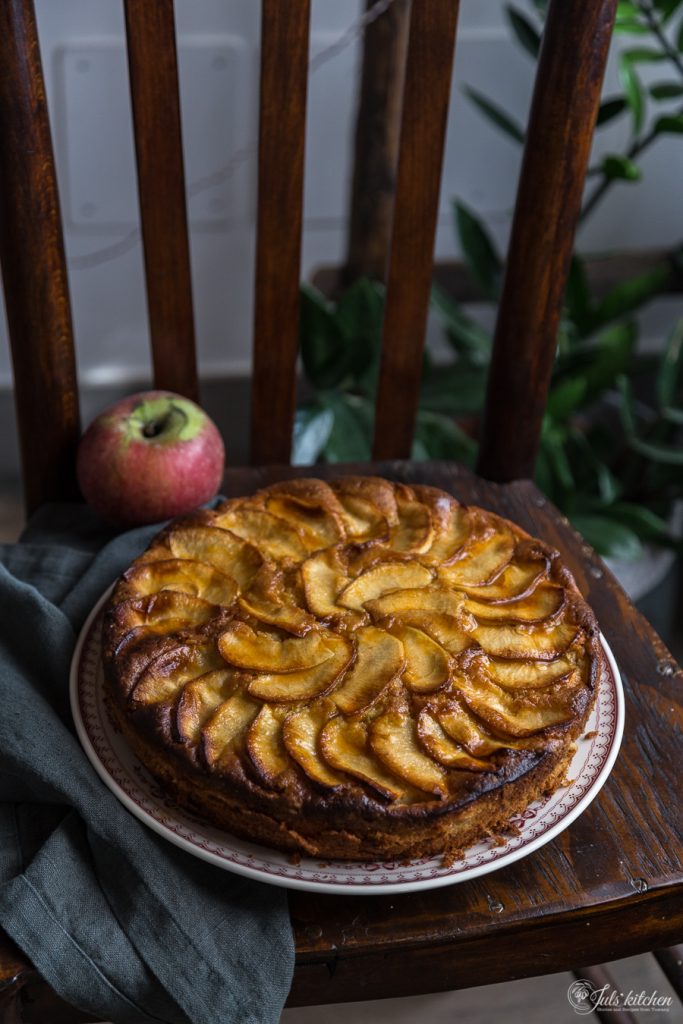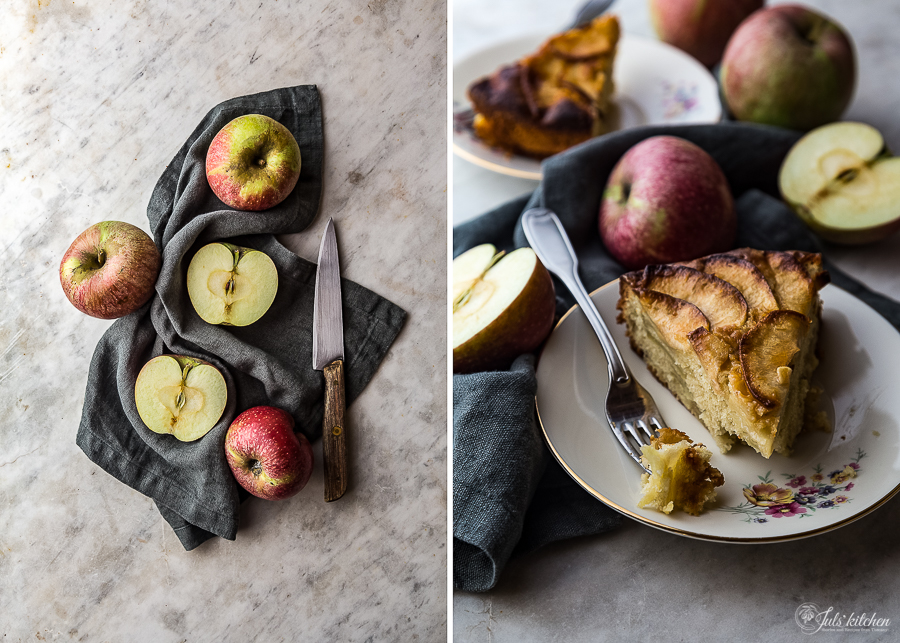Apple olive oil cake. A recipe from my cooking repertoire.
Sit with me. Let me pour you a cup of tea. There are fragments of a warm autumn afternoon light playing on the table, among the teacups. It’s an everyday afternoon, but we will make it stand out just by choosing your favourite cup, just by stealing ten minutes in the unstoppable flowing of time, just by slicing an apple olive oil cake.
It looks like one of those cakes that you can buy at the local bakery, shimmering on the surface, a pattern of crescent-shaped apple slices. A subtle aroma of apples and cardamom lingering in the house reveals the truth, though: you just baked that apple cake, you whisked the ingredients pouring in herbaceous olive oil, a pinch of cardamom, handfuls of apple slices.
You made that pattern by carefully arranging more apple slices on top, one next to the other, as if they wanted to protect themselves from cold wind, standing shoulder to shoulder. A tablespoon of apricot jam, diluted in hot water and simmered on the stovetop, is the final polish for your apple carpet. It captures the light and reflects it.

It’s always handy to have an apple olive oil cake in your cooking repertoire.
Months ago I decided to share these recipes, staples of a Tuscan repertoire, analyzing the ingredients and the process with plenty of details so that, if you want, you’ll be able to include them into your collection and make Tuscan cooking your signature style.
After the crespelle alla fiorentina and the eggplant meatballs is time to include a dessert, a humble Tuscan apple olive oil cake.
You can dress it up for a dinner party: serve a slice of warm apple cake with a scoop of vanilla gelato, a cloud of whipped cream or a drizzle of custard. Wrap in foil a slice of cake for a school break or an office break. Bake the olive oil apple cake on a Sunday and enjoy it for breakfast on the first days of the week with a strong coffee or a cappuccino. Keep a slice of cake for an afternoon tea: you don’t need to set a table with china and a lace tablecloth. Choose your favourite tea, brew it and have a well-deserved break with a slice of cake.

Extra virgin olive oil.
This is my favourite ingredient, something that in my book deserves a little investment as it can completely uplift your cooking. I cook with extra virgin olive oil, fry with it, bake with it. If you don’t feel like using extra virgin olive oil you can substitute it with a cold-pressed sunflower seed oil or rice oil, which have definitely a more delicate taste.
I am used to the aroma of olive oil in a cake, and I do appreciate it, especially when paired with lemon juice, as in this cake: it gives the most humble apple cake a Mediterranean twist.
Apples.
I usually bake with gala apples, but feel free to choose the apples you prefer. The best apples are those that sit in the bowl on your kitchen counter. This is quite an apple loaded cake, as there are three thinly sliced in the batter and one on the top, so you’ll have a moist cake which will keep well for a few days, even on your kitchen counter.
Cardamom.
It is not a Tuscan spice, on this we can agree. Usually, apple cakes are spiced up with cinnamon or vanilla, but my sister literally hates cinnamon, so I’ve been using cardamom a lot, especially as I love to share a slice of cake and a cup of tea with her when she comes back from work in the afternoon. Again, feel free to experiment and choose your signature spice. Always opt for natural flavourings such as a real vanilla pod, grated zest of lemon or orange, spices… and avoid chemical essences.

Apple olive oil cake
And now, the recipe. Try it, make it yours, scrape the batter in your worn-out cake mould (I am sure you have one, I still use my grandma’s one and it’s the best), bake it in your family, share it with your friends. Then, if you want, come back here and let me know how you like it and how you changed it to meet your taste.
Apple olive oil cake
Ingredients
- 4 apples
- 1 lemon juice
- 4 medium eggs
- 180 g sugar, 2 tablespoons for the apples
- 120 ml extra virgin olive oil
- 240 g all-purpose flour
- 8 g baking powder
- ½ teaspoon cardamom powder
- 1 pinch fine sea salt
- Butter to grease the cake mould
- 2 tablespoons apricot jam
Instructions
- Preheat oven to 175°C (350°F).
- Peel, core, and slice three apples. Put aside the fourth apple, you’ll need it later. Collect the apple slices in a bowl, drizzle them with the juice of a lemon and sprinkle them with two tablespoons of sugar. Give them a quick stir and set aside.
- Whip eggs and sugar until light and foamy. Whisk in the extra virgin olive oil, then fold the flour sifted with baking powder, cardamom and salt.
- Now add the apples, pouring in also the lemon juice left in the bowl. Fold the apples gently into the batter.
- Grease a 26cm / 10in round cake mould with a knob of butter and dust it with flour. Scrape the batter into the cake mould and smooth the surface with a spatula.
- Peel, core, and slice the apple you put aside. Use the apple slices to decorate the surface of the cake, placing them in concentric circles, starting from the outside.
- Bake the cake in a hot oven for about 45-50 minutes, checking if the cake is done with a toothpick: when you insert it in the centre of the cake, it should come out clean.
- Once ready, remove the cake from the oven, allowing it a few minutes to cool down on a wire rack, then remove it from the cake mould and place it on a serving plate.
- Dissolve the apricot jam in a saucepan with two tablespoons of water, warming it on low heat until it starts to boil. Brush the cake with the apricot glaze. Let it cool down completely before slicing it.
- It keeps well for a few days on your kitchen counter, covered with a paper napkin or a kitchen towel.
Notes

An apple olive oil cake in your cooking repertoire
After reading Cooking for Mr. Latte, by Amanda Hesser, I fell in love with the concept of having a cooking repertoire, and I decided to share here on the blog these recipes, staples of a Tuscan repertoire, analysing the ingredients and the process with plenty of details so that, if you want, you’ll be able to include them into your collection and make Tuscan cooking your signature style.
I chose these recipes not to impress, but to nourish them, and because, using Amanda Hesser’s words, they would express my true sensibility as a cook, not my ambition.
All the recipes of my cooking repertoire
These are all the recipes I added so far into my cooking repertoire. This is an ever-growing list, an always expanding collection that represents the way I live Tuscan food and cooking. Have you already tried something?
- Crespelle alla fiorentina. It is a handy recipe to learn as you can vary the filling according to the season: asparagus, artichokes and butternut squash are some of my favourites along with spinach and Swiss chard. You can mix the vegetables with fresh milky ricotta or add some béchamel into the filling. Cheese is a welcomed ingredient: Parmigiano Reggiano, Tuscan or Roman Pecorino, ricotta salata, or any other savoury aged cheese that you would happily grate over your pasta.
- Ricotta and Tuscan kale gnudi. There are two crucial ingredients here that can help you ease the anxiety while waiting for your gnudi to float to the top: ricotta and cavolo nero, the Tuscan kale. Use well-drained ricotta and squeeze very well the cooked kale. Once you make this, they will be your next success in the kitchen.
- Tuscan ragù. The Tuscan ragù is cooked with red wine, poured in little by little, and with tomato purée (just tomatoes that have been peeled and blended into a sauce), even better if it is your homemade tomato purée, made during the heat of summer. To give more character to the ragù and have a more rustic sauce, sometimes I prefer to replace the passata with the same weight of peeled tomatoes, roughly crushed with my hands.
Main courses and side dishes
- Beef and eggplant meatballs. According to the season, you can substitute roasted eggplants with boiled potatoes, roasted butternut squash or breadcrumbs soaked in milk. I usually choose between grated Parmigiano Reggiano, aged Pecorino or Provolone to add flavour to the meat, sometimes adding brined capers, too. This time I opted for Parmigiano, along with a pinch of dry oregano to give a Mediterranean touch.
- Stuffed turkey breast. One of the recipes that my mum taught me and that I immediately associate with Sunday lunches is the stuffed turkey breast, roasted on the stovetop and not in the oven. It is a humble dish, but it has enormous potential.
- Baked eggplants. Colours and textures of that once loved recipe surfaced along with the ingredients: eggplants, of course, either the round purple ones or those thin long ones, then breadcrumbs, parsley, capers, garlic and some grated Parmigiano. There it was, my forgiving recipe, thick slices of eggplants topped with boldly flavoured breadcrumbs, roasted in the oven until golden and crisp.
- Italian potato salad. So a potato salad, which I had overlooked for years, becomes a distinguishing element of a menu, especially if you dress it with an Italian twist, with wild fennel, capers and olives. You can find the same aromas in a roasted pork loin with olive oil and wine, or in the baked eggplants that you are planning to serve as an appetiser.
Desserts
- Coffee and vanilla pound cake. A versatile recipe to make a pound cake with the ingredients you have at hand, with a detailed explanation of the four macro-categories of ingredients you can use, plus a recipe for a vanilla pound cake marbled with coffee, designed to wake you up in the morning. Use white farro flour, white sugar and dark cane sugar, Greek yoghurt and butter.
- Ricotta crumb cake. I still have to decide if I prefer the cake warm from the oven, or after a few hours of the fridge. This ricotta crumb cake is an unmissable summer cake, and I’ll let you decide when to serve it if you are in hurry or armed with adamant patience.
Link Love
- Apparently, Ottolenghi has a recipe for an apple olive oil cake in his latest cookbook, with a maple frosting, too. I discovered the recipe in Megan’s blog, A sweet spoonful.
- Aran has a recipe for a gluten-free apple, olive oil and yoghurt cake, and she has also a stunning video for that!
- A very unusual apple cake, parsnip and apple breakfast cake by Miss Foodwise.
- I read this article and suddenly I felt less of a failure in trying to balance work and life. Yet shift it must. Change it must. For “balance” implies stasis – and stasis is antithetical to the creative life.
- On a side note, a few months ago I answered a request by MyHeritage to have my DNA tested, I was so curious. Finally, I got my results! I am mainly Mediterranean, a clear 87,7%: no suspect, though a 42% from Greece explains my love for tzatziki, sirtaki and My Big Fat Greek Wedding. This test also reveals what I have always suspected, too: I have a fraction of Irish, Scottish and Welsh blood in my veins, and this explains so many things, like, a lot!











Hi, Giulia! I’ve been reading your blog for a few weeks now and I love it! The recipes, the pictures and the stories – all of it. You are a really talented person. Oh, how I would love to drink this cup of tea with you and have a slice of your cake and talk. I’ve already made two of your recipes: pasta with broccoli and chocolate cake with pears – my children loved both and so did I.
I must think of your cooking classes. Greetings from Poland to you and your family!
Grazie! This is just the type of recipe I want to share with my readers. A recipe that epitomizes the rustic Italian desserts. My mamma talked of fruit and sweets that weren’t really THAT sweet. I did a quick Ancestry DNA test too — I have Greek, Southern Italian, Northwestern European, East European. I’m certainly a mix — I was born in Northeastern Italy. Whew! I’m going to have to investigate this further. Back to the recipe, I’ve already pinned it and naturally, I’ll credit you and link back here. Buona serata!
Thank you for posting this recipe. I think it will be a perfect ending to the Thanksgiving dinner I will host next month. Instead of an apple pie this will be a lovely new tradition! Grazie!
This cake looks lovely! I just returned from a trip to Tuscany. Oh my, I fell in love! My DNA shows almost totally English, Welsh, Irish. (I live in the USA). So where is the Italian? I have always been drawn to Italy and it’s food. Many of my friends growing up were Italian and I had the pleasure of eating some wonderful bread and pasta from their grandmothers!! Anyway, I look forward to trying this cake, but I have one question. When you say a hot oven, around what temperature would that be? I will get back to you after I’ve made the cake. Thanks!
Oven should be 180°C. I guess your Italian DNA must be somewhere among your your childhood memories! 🙂
Very good! Looks just like in the photo. I love cardamon so maybe I will increase that next time and maybe drop the sugar a little. Another success!
It makes me so happy when the cake looks like the photo! Definitely reduce the sugar is it is too sweet, it depends also on the apples used!
Hi… I would love to try this but I am gluten intolerant. Can you suggest an alternative for the cake flour, please? I see you offer gluten free cooking classes. My husband and I will be in the Montepulciano area in October so will contact you soon about your menus. Ciao for now!
Hello Heather, I’ve never tried this recipe with gluten free flour, but you might try with half almond meal and half potato starch? let me know if this works!
Hi Giulia,
I am a new follower – can’t wait to try this first recipe! I am wondering if you might know how cake pan size affects bake time. The one I have at home is 8in. (roughly 20 cm.) and I’m curious if I should increase/decrease temperature or time.
Thank you!
Nina
Hi Giulia!
I love, love, love your blog! The way you write your posts is amazing!
I have one question for the recipie: can I replace the sugar with stevia? I use 1:5 stevia (ratio to sugar). Will it be ok or will I destroy the cake?
Thanks and keep up the good work!
Kisses from Greece
Hi Tatiana, thank you so much!! I must confess I never tried using stevia, so I’m not sure about the result. This is quite a smile cake, though, I guess it might work as well!
Buonasera Giulia,
I came across your site about two week’s ago, and I love it!!
I have told quite a few people about it.
I made today – first of your recipes, this wonderful apple olive oil cake…. it is absolutely very delicious and special. Adding cardamon is a real plus.
Thank you to you and Tommaso so much for sharing your stories and recipes.
Salute from Cassandra in Madrid, Spagna
Ps Next time I will take a photo!
Your apple cake is fabulous and delicious. I am going to try this. I love your blog. I tried this when my friends came.They loved it.Thanks .Keep posting.
Hey there! Love this cake, it turned out super awesome ! So thanks for this recipe:)
Although I had to modify a few things:
1. Used almond flour and coconut flour mix for the flour
2. Made only half the serving size: substituted half the quantity of sugar with maple syrup
3. Added cinnamon and cardamom
4. For some reason had to bake for a really really long time ( about an hour at 180F) and finally went up to 250 F for another 20 mins for the cake to be done
thank you for tour feedback, I am happy to know that it works also with an almond flour and coconut flour mix!
As for the Lon time it took to bake it, it is because I baked the cake at 180°C, which is 356°F!
Haha! Thank you, that was my mistake then not noting the Celsius.
Hi Giulia, I made this cake last week with pears and vanilla (instead of apples and cinnamon) and it turned out perfect! Like we stay ‘this is a keeper’ : will stay in the repertoire. Thank you!
that’s great Barbara. I still have to try to use pears in this cake, I’ll try it soon!
This cake is a pure delight ! The recipe is perfect as is, I have not changed anything and it turned out perfectly moist and tasty and good looking 🙂
I have used a mix of cinnamon/vanilla/black pepper instead of cardamom.
Many thanks for your sharing !
Now I feel like testing all the recipes from your repertoire ! 😉
thank you so much Céline. It is always exciting when someone replicates the recipes without any changes, it means the recipe works! and I’m so intrigued by the black pepper in the spice mix!
The spice mix I used is one created by a Michelin starred French chef, Olivier Roellinger, and is called “Poudre Equinoxiale”.
It is quite famous among French foodistas 😉
The black pepper is barely perceivable, but gives a nice hot kick…
now I need to find it!!
I am so happy I found your website when looking for a new potato salad. Your recipe was amazing and I now cannot stop dreaming of all your recipes. Baked Eggplants are on the menu tonight. I will be making the Apple Olive Oil Cake for my husband….Maybe tonight also. But I have no cake flour. Is all purpose flour acceptable or should I wait to get the cake flour?
Hi Deborah, I’m so happy you found my blog, welcome here! Let me know how the eggplants will turn out! As for the apple cake, all-purpose is perfect!
Delicious recipe, Giulia! The only minor changes I made were using 3 large eggs instead of 4 medium (being the size I had on hand), and I increased the cardamom to 3/4 tsp and included a 1/4 tsp of cinnamon, because I love both so much! I predict this treat will make a regular appearance in our home. Thank you for sharing!
Giulia, I’m enjoying your writing enormously and once winemaking season is over hope to start doing a bit of cooking for pleasure again. Tell me though, are your oven temperatures based on fan forced or conventional as of course there is quite a difference. Most domestic ovens in Australia tend to be fan forced although often one can use them either way.
Thank you so much, Bob! Whenever I bake cakes I use a conventional oven. So if your oven is just fan forced, reduce the temperature by 20°C.